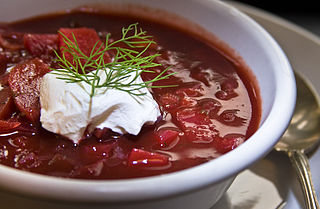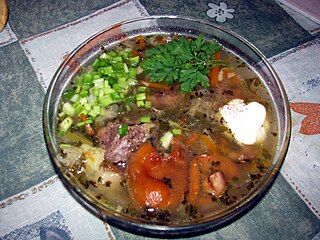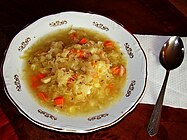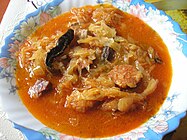
Borscht is a sour soup, made with meat stock, vegetables and seasonings, common in Eastern Europe and Northern Asia. In English, the word "borscht" is most often associated with the soup's variant of Ukrainian origin, made with red beetroots as one of the main ingredients, which give the dish its distinctive red color. The same name, however, is also used for a wide selection of sour-tasting soups without beetroots, such as sorrel-based green borscht, rye-based white borscht, and cabbage borscht.

Polish cuisine is a style of food preparation originating in and widely popular in Poland. Due to Poland's history, Polish cuisine has evolved over the centuries to be very eclectic, and shares many similarities with other national cuisines. Polish cooking in other cultures is often referred to as à la polonaise.

Russian cuisine is a collection of the different dishes and cooking traditions of the Russian people as well as a list of culinary products popular in Russia, with most names being known since pre-Soviet times, coming from all kinds of social circles.

Shchi is a Russian-style cabbage soup. When sauerkraut is used instead, the soup is called sour shchi, while soups based on sorrel, spinach, nettle, and similar plants are called green shchi. In the past, the term sour shchi was also used to refer to a drink, a variation of kvass, which was unrelated to the soup.

Lithuanian cuisine features products suited to the cool and moist northern climate of Lithuania: barley, potatoes, rye, beets, greens, berries, and mushrooms are locally grown, and dairy products are one of its specialties. Various ways of pickling were used to preserve food for winter. Soups are extremely popular, and are widely regarded as the key to good health. Since it shares its climate and agricultural practices with Northern Europe, Lithuanian cuisine has much in common with its Baltic neighbors and, in general, northern countries.

Ukrainian cuisine is the collection of the various cooking traditions of the people of Ukraine, one of the largest and most populous European countries. It is heavily influenced by the rich dark soil (chornozem) from which its ingredients come, and often involves many components. Traditional Ukrainian dishes often experience a complex heating process – "at first they are fried or boiled, and then stewed or baked. This is the most distinctive feature of Ukrainian cuisine".

Pennsylvania Dutch cuisine is the typical and traditional fare of the Pennsylvania Dutch. According to one writer, "If you had to make a short list of regions in the United States where regional food is actually consumed on a daily basis, the land of the Pennsylvania Dutch—in and around Lancaster County, Pennsylvania—would be at or near the top of that list," mainly because the area is a cultural enclave of Pennsylvania Dutch culture.

Bulgarian cuisine is part of the cuisine of Southeast Europe, sharing characteristics with other Balkan cuisines. Bulgarian cooking traditions are diverse because of geographical factors such as climatic conditions suitable for a variety of vegetables, herbs, and fruit. Aside from the variety of local Bulgarian dishes, Bulgarian cuisine shares a number of dishes with its neighboring countries, in particular with the Turkish and Greek cuisine.

Bigos, often translated into English as hunter's stew, is a Polish dish of chopped meat of various kinds stewed with sauerkraut, shredded fresh cabbage and spices. It is served hot and can be enriched with additional vegetables and wine. Originally from Poland, the dish also became traditional in the areas of the vast Polish–Lithuanian Commonwealth.

Czech cuisine has both influenced and been influenced by the cuisines of surrounding countries and nations. Many of the cakes and pastries that are popular in Central Europe originated within the Czech lands. Contemporary Czech cuisine is more meat-based than in previous periods; the current abundance of farmable meat has enriched its presence in regional cuisine. Traditionally, meat has been reserved for once-weekly consumption, typically on weekends.

Belarusian cuisine refers to the culinary traditions native to Belarus. It shares many similarities with cuisines of other Eastern, Central and Northeastern European countries, based predominantly on meat and various vegetables typical for the region.

Sorrel soup is made from water or broth, sorrel leaves, and salt. Varieties of the same soup include spinach, garden orache, chard, nettle, and occasionally dandelion, goutweed or ramsons, together with or instead of sorrel. It is known in Ashkenazi Jewish, Belarusian, Estonian, Hungarian, Latvian, Lithuanian, Romanian, Armenian, Polish, Russian and Ukrainian cuisines. Its other English names, spelled variously schav, shchav, shav, or shtshav, are borrowed from the Yiddish language, which in turn derives from Slavic languages, like for example Belarusian шчаўе, Russian and Ukrainian щавель, shchavel, Polish szczaw. The soups name comes ultimately from the Proto-Slavic ščаvь for sorrel. Due to its commonness as a soup in Eastern European cuisines, it is often called green borscht, as a cousin of the standard, reddish-purple beetroot borscht. In Russia, where shchi has been the staple soup, sorrel soup is also called green shchi. In old Russian cookbooks it was called simply green soup.

Zasmażana kapusta, known to many Polish people simply as kapusta [kah-POOS-tah], is a Polish dish of braised or stewed sauerkraut or cabbage, with bacon, mushroom and onion or garlic. It is seasoned with salt, pepper and sometimes bay leaf, caraway seeds, sugar, paprika and apples. The traditional dish is usually served along with boiled potatoes as an accompaniment for pork chops, pork cutlets, other pork dishes, veal, or game meats. In some homes, kapusta is served very thin, almost like a soup. In others, its ingredients are thickened with flour or cooked until it becomes nearly as thick as mashed potatoes. It has been described as less sour in flavor compared to German sauerkraut.

Főzelék is a type of thick Hungarian vegetable stew or soup, similar to pottage. Főzelék is a special category in Hungarian cuisine, not quite like a soup, and thinner than a stew. It is simply cooked, typically by simmering, not mashing. It is usually not cooked with meat, but bacon and spicy sausage may be added for flavor. Főzelék is often eaten as the main course for lunch or like a garnish for different meat courses. Főzelék was typically a home-made food, and was considered as an ordinary type of meal so traditionally it seldom appeared on restaurant menus but in recent years, as part of the culinary revolution in Hungary, főzelék enjoys a revival and it is much more common to be found on menus, there are even places dedicated to offering various főzelék as main course.

Ashkenazi Jewish cuisine is an assortment of cooking traditions that was developed by the Ashkenazi Jews of Central, Eastern and Northern Europe, and their descendants, particularly in the United States and other Western countries.



















